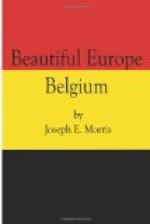The great Van Eyck is hung in a chapel on the south
of the choir, and the services of the verger must be
sought for its exhibition. The paintings on the
shutters are merely copies by Coxie, six of the originals
being in the Picture Gallery in Berlin. Their
restoration to Ghent, one hopes, will form a fractional
discharge of the swiftly accumulating debt that Germany
owes to Belgium. The four main panels, however,
are genuine work of the early fifteenth century, the
reredos as a whole having been begun by Hubert, and
finished by Jan van Eyck in 1432. The centre-piece
is in illustration of the text in the Apocalypse (v.
12): “Worthy is the Lamb that was slain
to receive power, and riches, and wisdom, and strength,
and honour, and glory, and blessing.” One
may question, indeed, if figurative language of the
kind in question can ever be successfully transferred
to canvas; whether this literal lamb, on its red-damasked
table, in the midst of these carefully marshalled
squadrons of Apostles, Popes, and Princes, can ever
quite escape a hint of something ludicrous. One
may question all this, yet still admire to the full
both the spirit of devotion that inspired this marvellous
picture and its miracle of minute and jewel-like execution.
There are scores of other good pictures in Ghent,
including (not even to go outside St. Bavon’s)
the “Christ among the Doctors” by Francis
Pourbus, into which portraits of Philip II. of Spain,
the Emperor Charles V., and the infamous Duke of Alva—names
of terrible import in the sixteenth-century history
of the Netherlands—are introduced among
the bystanders; whilst to the left of Philip is Pourbus
himself, “with a greyish cap on which is inscribed
Franciscus Pourbus, 1567.” But it is always
to the “Adoration of the Mystic Lamb”
that our steps are first directed, and to which they
always return.
It is hard, indeed, that necessities of space should
compel us to pass so lightly over other towns in Flanders—over
Courtrai, with its noble example of a fortified bridge,
and with its great picture, by Van Dyck, of the “Raising
of the Cross” that was stolen mysteriously a
few years ago from the church of Notre Dame, but has
since, like the Joconde at the Louvre, been recovered
and replaced; over Oudenarde, with its two fine churches,
and its small town hall that is famous for its splendour
even in a country the Hotels de Ville of which are
easily the most elaborate (if not always the most
chaste or really beautiful) in Europe; and over certain
very minor places, such as Damme, to the north-east
of Bruges, whose silent, sunny streets, and half-deserted
churches, seem to breathe the very spirit of Flemish
mediaevalism. Of the short strip of Flemish coast,
from near Knocke, past the fashionable modern bathing-places
of Heyst, Blankenberghe, and Ostende, to a point beyond
La Panne—from border to border it measures
roughly only some forty miles, and is almost absolutely
straight—I willingly say little, for it
seems to me but a little thing when compared with




